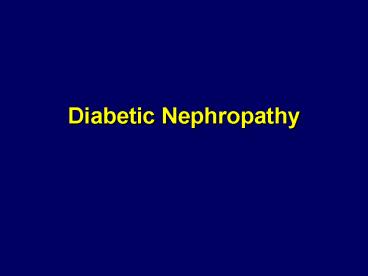Diabetic Nephropathy - PowerPoint PPT Presentation
1 / 16
Title:
Diabetic Nephropathy
Description:
In 2001, 41,312 people with diabetes began treatment for end-stage renal disease. ... captopril, enalapril, lisinopril, benazepril, fosinopril, ramipril, quinapril, ... – PowerPoint PPT presentation
Number of Views:621
Avg rating:5.0/5.0
Title: Diabetic Nephropathy
1
Diabetic Nephropathy
2
Diabetic Nephropathy
- Over 40 of new cases of end-stage renal disease
(ESRD) are attributed to diabetes. - In 2001, 41,312 people with diabetes began
treatment for end-stage renal disease. - In 2001, it cost 22.8 billion in public and
private funds to treat patients with kidney
failure. - Minorities experience higher than average rates
of nephropathy and kidney disease
3
Five Stages of Kidney Disease
Stage 1 Hyperfiltration, or an increase in
glomerular filtration rate (GFR) occurs. Kidneys
increase in size. Stage 2 Glomeruli begin to
show damage and microalbuminurea occurs. Stage
3 Albumin excretion rate (AER) exceeds 200
micrograms/minute, and blood levels of creatinine
and urea-nitrogen rise. Blood pressure may rise
during this stage.
4
Five Stages of Kidney Disease (cont.)
Stage 4 GFR decreases to less than 75 ml/min,
large amounts of protein pass into the urine, and
high blood pressure almost always occurs. Levels
of creatinine and urea-nitrogen in the blood rise
further. Stage 5 Kidney failure, or end stage
renal disease (ESRD). GFR is less than 10 ml/min.
The average length of time to progress from Stage
1 to Stage 4 kidney disease is 17 years for a
person with type 1 diabetes. The average length
of time to progress to Stage 5, kidney failure,
is 23 years.
5
Screening for Diabetic Nephropathy
1American Diabetes Association Nephropathy in
Diabetes (Position Statement). Diabetes Care 27
(Suppl.1) S79-S83, 2004
6
Treatment of Diabetic Nephropathy
- Hypertension Control - Goal lower blood pressure
to lt130/80 mmHg - Antihypertensive agents
- Angiotensin-converting enzyme (ACE) inhibitors
- captopril, enalapril, lisinopril, benazepril,
fosinopril, ramipril, quinapril, perindopril,
trandolapril, moexipril - Angiotensin receptor blocker (ARB) therapy
- candesartan cilexetil, irbesartan, losartan
potassium, telmisartan, valsartan, esprosartan - Beta-blockers
7
Treatment of Diabetic Nephropathy (cont.)
- Glycemic Control
- Preprandial plasma glucose 90-130 mg/dl
- A1C lt7.0
- Peak postprandial plasma glucose lt180 mg/dl
- Self-monitoring of blood glucose (SMBG)
- Medical Nutrition Therapy
- Restrict dietary protein to RDA of 0.8 g/kg body
weight per day
8
Treatment of End-Stage Renal Disease (ESRD)
- There are three primary treatment options for
individuals who experience ESRD - 1. Hemodialysis
- 2. Peritoneal Dialysis
- 3. Kidney Transplantation
9
Hemodialysis
- Procedure
- A fistula or graft is created to access the
bloodstream - Wastes, excess water, and salt are removed from
blood using a dialyzer - Hemodialysis required approx. 3 times per week,
each treatment lasting 3-5 hrs - Can be performed at a medical facility or at home
with appropriate patient training
10
Hemodialysis (cont.)
- Hemodialysis Diet
- Monitor protein intake
- Limit potassium intake
- Limit fluid intake
- Avoid salt
- Limit phosphorus intake
- Complications
- Infection at access site
- Clotting, poor blood flow
- Hypotension
11
Peritoneal Dialysis
- Procedure
- Dialysis solution is transported into the abdomen
through a permanent catheter where it draws
wastes and excess water from peritoneal blood
vessels. The solution is then drained from the
abdomen. - Three Types of Peritoneal Dialysis
- Continuous Ambulatory Peritoneal Dialysis (CAPD)
- Continuous Cycler-Assisted Peritoneal Dialysis
(CCPD) - Combination CAPD and CCPD
12
Peritoneal Dialysis (cont.)
- Peritoneal Dialysis Diet
- Limit salt and fluid intake
- Consume more protein
- Some potassium restrictions
- Reduce caloric intake
- Complications
- Peritonitis
13
Kidney Transplant
- Procedure
- A cadaveric kidney or kidney from a related or
non-related living donor is surgically placed
into the lower abdomen. - Three factors must be taken into consideration to
determine kidney/recipient match - Blood type
- Human leukocyte antigens (HLAs)
- Cross-matching antigens
14
Kidney Transplant (cont.)
- Kidney Transplant Diet
- Reduce caloric intake
- Reduce salt intake
- Complications/Risk Factors
- Rejection
- Immunosuppressant side effects
- Benefits
- No need for dialysis
- fewer dietary restrictions
- higher chance of living longer
15
How Can You Prevent Diabetic Kidney Disease?
- Maintain blood pressure lt130/80 mm/Hg
- Maintain preprandial plasma glucose 90-130 mg/dl
- Maintain postprandial plasma glucose lt180 mg/dl
- Maintain A1C lt7.0
16
References
- American Diabetes Association Nephropathy in
Diabetes (Position - Statement). Diabetes Care 27 (Suppl.1) S79-S83,
2004 - National Kidney and Urologic Diseases Information
Clearinghouse. - Kidney Disease of Diabetes. Bethesda, MD
National Institute of - Diabetes and Digestive and Kidney Diseases,
National Institutes of - Health (NIH), DHHS 2003.
- United States Renal Data System. USRDS 2003
Annual Data - Report. Bethesda, MD National Institute of
Diabetes and Digestive - and Kidney Diseases, National Institutes of
Health (NIH), DHHS - 2003.
- DeFronzo RA Diabetic nephropathy etiologic and
therapeutic - considerations. Diabetes Reviews 3510-547, 1995
- National Kidney and Urologic Diseases Information
Clearinghouse. - Kidney Failure Choosing a Treatment Thats Right
For You. - Bethesda, MD National Institute of Diabetes and
Digestive and































